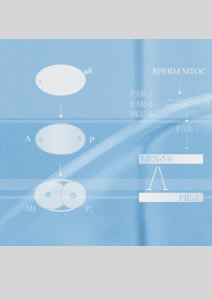FIRST GENERATION pie-1 VECTORS
Melanie Dunn, Kim Reese and Geraldine Seydoux
We have used sequences from the pie-1 gene to construct a
vector designed to express GFP fusions in the adult germline
and in early embryos. The pie-1 gene encodes a maternal
RNA transcribed in the adult germline and inherited maternally
in embryos (Mello et al., 1992, 1996; Tenenhaus et al., 1998).
An 8kb genomic fragment from the pie-1 locus is sufficient
to rescue a pie-1 mutation (Reese et al., 2000, Tenenhaus
et al., 2001). We modified this fragment to allow expression
of heterologous GFP fusions.
The resulting vector includes (from 5’ to 3’)
the pie-1 large intron, the pie-1 promoter,
GFP, a specific ORF (see below) , the pie-1 3’UTR,
and additional 3’ sequences. The pie-1 vector
is available in 4 different versions each with a different
ORF inserted downstream of GFP.
1st generation pie-1 vectors:
| pJH4.52 |
pie-1prom:GFP:histone
H2B (F54E12.4) fusion. |
|
|
| pJH4.64 |
pie-1prom:GFP:act-1 |
|
|
| pJH4.66 |
pie-1prom:GFP:beta-tubulin |
|
|
| pJH4.67 |
pie-1prom:GFP:gamma-tubulin |
|
|

(download sequence in MS Word) 
(download graphic map in PDF) |
Useful cloning sites:
SpeI sites flank each ORF, and can be used to replace these
sequences with other ORFs to make new GFP fusions.
BamHI sites flank the GFP:ORF, and can be used to replace
these fusions with others.
Complex array injections:
We use complex arrays (Kelly et al., 1997) to express these
constructs in the germline.
Typical injection mix:
| pJH4.52 linearized with SacII |
1ug/ml |
| pRF4 linearized with EcoRI |
1ug/ml |
| N2 genomic DNA digested with PvuII |
60ug/ml |
We routinely inject 50-60 worms and obtain 15-40 F1 rollers.
These are cloned to individual plates and checked for roller
progeny (F2) - between 10 to 30% of F1 rollers will give
F2 rollers.
Gravid F2 adult rollers are then examined for GFP expression
in their germline and embryos. You should see some GFP expression
in several lines, although expression levels can vary greatly
from line to line.
In most lines, expression will diminish in the F3 and F4
generations, although a minority of lines may remain stable.
Keeping the lines at 25oC improves GFP expression although
it may lead to sick worms.
What you should see:
All three constructs express in the adult germline (strongest
in proximal germ cells), and in all blastomeres of early
embryos.
pJH4.52: GFP on chromosomes
pJH4.64: GFP on cortical actin and cell division remnants.
pJH4.66: GFP on centrosomes, meiotic and (more weakly) mitotic
spindles
With all constructs, you will also see significant
expression in various somatic cells in adults; this
expression may depend on N2 DNA sequences present in the
complex array.
|


